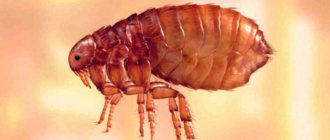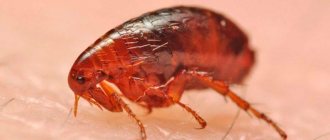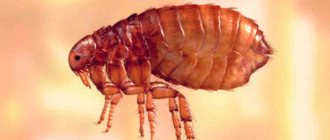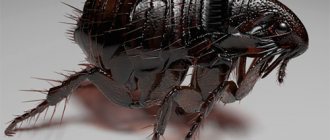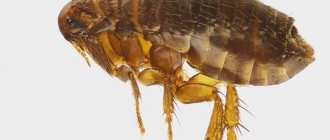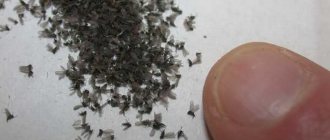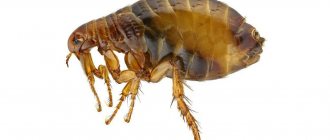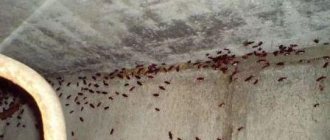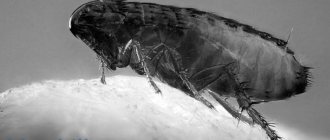- Symptoms of flea bites in humans
- First aid for a flea bite
- Relieving inflammation after a flea bite
- Itching relievers
- Treatment of flea bites in people with folk remedies
- Ointments for flea bites
- Preparations for healing wounds from bites
- Proven repellents
- What are the dangers of flea bites?
- Preventive measures
In the spring and summer seasons, flea bites on the human body are not uncommon. Unlike mosquitoes, they are painful and take longer to heal. Associated itching, allergic reactions and the risk of infection in the wound require immediate action. Let's look at which flea bite remedies work faster and more effectively than others.
Symptoms of flea bites in humans
A flea bite on the body looks like a reddened, swollen bump, firm when pressed, without visible bubbles on the top. In the center of the swelling we can see a puncture of the skin.
The most common places where blood-sucking pests bite:
- feet;
- shins;
- ankles;
- less often - the popliteal fossa, the lower third of the thigh.
Symptoms of a flea bite are essentially a manifestation of the body's allergic reaction to the insect's saliva. The most characteristic signs:
- A painful sensation at the time of the bite, similar to a needle prick.
- The immediate reaction is itching and burning.
- Redness of the skin with the formation of characteristic bumps in the affected areas.
- The appearance of swelling of the skin near the bite.
If the swelling is combed uncontrollably, then an open wound appears in this place, into which infections can enter. As a result, a person:
- body temperature rises;
- weakness, irritability, headache appear;
- the wound begins to bleed and fester;
- in extreme cases, blood poisoning occurs.
The most dangerous possible consequences of bloodsucking bites: anaphylactic shock and Quincke's edema are rare. However, when the first signs of hypersensitivity to a bite appear (difficulty breathing, rash all over the body, loss of consciousness), the victim needs qualified medical care or hospitalization.
The wound of a person bitten by fleas is a chain of 3-4 punctures. Later, red dots with swelling appear on it. A person complains of unbearable itching.
When the wounds heal, a dull red rash sometimes persists. Children may develop impetigo after being bitten.
Usually insects bite a person's feet. This is explained by the inability to crawl on the body. But when a person is sleeping, they are able to bite the skin anywhere.
After the puncture, the parasite drinks blood, causing the person to experience pain reminiscent of a needle prick. The flea, unlike other parasites, does not inject anesthetic substances into the wound.
When bitten, toxic enzymes enter the bloodstream, causing it to clot poorly. Thanks to this, blood flows into the parasite’s stomach on its own, in a thin stream.
When the insect detaches itself from the bite site, the elastic walls of the skin close and prevent blood from escaping. But sometimes bleeding continues under the skin, resulting in hemorrhagic syndrome. If there are a lot of bites in one place, bleeding can turn into purpura, which is dangerous to health.
If a person suffers from allergies, redness spreads throughout the body. The general condition changes: the temperature rises, difficulty breathing, migraine, weakness, upset stool.
Signs of a parasite
Do fleas live on people? Permanently - no, parasites live on the fur of pets for a long time. They visit a person to have a hearty and satisfying meal, and then they can move onto a cat or into the carpet pile. These are not lice that live on the body permanently. Fleas live on humans only while they feed. Therefore, the question: are fleas transmitted from cats to humans is itself formulated incorrectly. There is no talk of any transfer from one owner to another.
Article on the topic: What is the difference between fleas and lice
Vampire fleas only quench their thirst, after which the female can hide in a secluded, dark and damp place to lay eggs. Males can live in animal bedding or garbage. Therefore, contaminated bedding, basements, and garbage cans can be a source of danger from which an attack will occur.
All secluded corners where annoying blood-sucking creatures hide are located close to warm-blooded animals and humans. They remain invisible and disappear after a bite. How fleas bite has been described before. If the skin is sensitive, the bite may be painful and small reddish spots may appear on the body. Fleas will attack constantly, so you need to know where they live:
- in the cracks of the floor between the boards,
- under the baseboard or threshold,
- in the pile of carpets and upholstered furniture,
- in linen and bedspreads, especially fluffy ones,
- in storerooms and basements,
- in the bedding of domestic animals.
Here they can reproduce, lay eggs and attack their potential victims.
Note: The development cycle of the parasite ranges from 2 weeks to a month, depending on living conditions. A larva emerges from the cocoon and searches for a host. If this happens en masse, large colonies develop. Up to 200 individuals can “live” in the fur of one animal at the same time.
First aid for a flea bite
If a bite occurs, wash the affected area with warm water and antiseptic soap. To relieve pain, apply ice or any product from the freezer to the wound.
Then the flea bites are treated with antiseptics. For this use:
- Chlorhexedine;
- Miramistin;
- Iodine;
- Hydrogen peroxide.
If the wound is very swollen and severe rashes appear around it, this indicates the development of a histamine reaction. In this case, antiallergic drugs are used internally and locally.
Among local drugs, Fenistil and Spasatel have proven themselves well. The gel is applied to the sore spot three times a day. The product relieves swelling, itching, and rash well.
Effective oral medications include: Zyrtec, Eden, Loratadine, Diazolin.
Antihistamines are available without a prescription, but must be prescribed by your doctor because they sometimes cause side effects.
If allergic manifestations are severe, hormonal medications are used. They are administered intravenously or intramuscularly.
Main dangers
To understand whether fleas are dangerous to humans, it is enough to find out what diseases fleas carry. Their list is quite extensive and looks threatening. The list of dangerous fleas includes more than 200 serious infectious diseases. Among them, the following are considered the most serious.
- Bubonic plague. Carried by rat fleas.
- Brucellosis.
- Salmonellosis.
- Typhoid
- Encephalitis.
- Helminthiases. Fleas are carriers of some types of tapeworms.
Fleas that carry diseases look no different from ordinary fleas. There is some species specificity, but given the small size of insects, it is impossible to establish it at home.
The list of dangers that animal fleas pose to humans includes an allergy to their bites, which leads to fever, scratching and eczema, especially in children. Scientists have also discovered why fleas do not bite all people. This is due to the blood type (for insects the first is preferable), as well as the structural features of the skin. Those with thin skin suffer more from bites. In addition, people differ in their degree of sensitivity to flea bites. A high level of sensitivity leads to the development of autoimmune reactions, severe itching, scratching and even anaphylactic shock.
The phrase that dog fleas are transmitted to humans is somewhat incorrect. They are capable of biting people, but do not live on the surface of human skin.
Relieving inflammation after a flea bite
While for some people a flea bite remains almost unnoticeable, for others it can turn into an inflammatory process.
To relieve inflammation use:
- Sulfur ointment (available without a prescription). The product is applied to the affected areas in a small amount. The ointment has an unpleasant odor, but the effect is noticeable after three applications.
- Infusion of celandine, wormwood, calendula, dandelion. To prepare, pour 15 g of dry herb with a glass of boiling water and let it brew for half an hour. Dip a cotton pad in the solution and lubricate the wounds.
- Calamine solution. The product contains zinc, which has healing properties. The drug is applied in a thin layer to the bites up to four times a day. There is no need to rinse the product off the skin.
Traditional medicine methods are used as additional therapy.
Protection against fleas on the street and in the wild
People are more often attacked by fleas on the streets. There is an even higher chance of becoming a food source for pests while traveling in the wild.
Fleas cannot fly, so the likelihood of them attacking a person is lower than a horsefly or mosquito. However, being an agile jumper, a flea can feast on a person’s blood and move into his house, hiding in the folds of clothing.
You can catch a flea in a city park or square, but the risk is low. But if a person passed by a heating main, went down to the basement or boiler room, then the danger increases significantly. This applies to plumbers and other workers who are forced to be present in the listed places due to their occupation.
Hunters, loggers, shepherds and foresters are also at risk. In the forest, in addition to various species of fleas that live in cities and villages, there is, for example, the elk flea. She feeds on blood, but is not a carrier of diseases - this is her only advantage compared to other fleas.
Special clothing and repellents help protect against bloodsuckers in nature.
Itching relievers
Products for relieving the sensation of itching, which only intensifies after scratching, are produced in the following format:
- ointments;
- sprays;
- emulsions;
- suspensions;
- tablets;
- lotions.
The following pharmacological compounds have proven their effectiveness:
- Calamine. The product is in the form of a white lotion based on zinc carbonate. Instantly relieves itching (the product is even used to relieve itching sensations during chickenpox), removes tissue swelling and promotes wound healing. The bite sites are treated with a cotton pad or swab dipped in the substance three times a day until the redness completely disappears. It has no contraindications and is used for adults and children.
- Fenistil. Local action gel relieves itching, burning and pain. Apply to the affected area 3-4 times a day. It is available in a convenient tube format, but has a number of contraindications. Not recommended for use on children, pregnant and lactating women.
- Flucinar. Hormonal ointment, which is recommended to be rubbed into the wound with massage movements twice a day. It has contraindications for use; it should be used only as prescribed by a doctor and no more than 2 g per day.
- Hydrocortisone. A glucocorticosteroid drug based on hormonal components. Available by prescription in 10 g tubes, used only for external use.
- Antihistamine tablets: Suprastin, Claritin, Loratadine, Diphenhydramine. Relieves allergy symptoms and is easy to use. However, the effect of relieving itching is not achieved immediately, but 20–30 minutes after taking the medicine. Tablets also do not protect the wound from inflammation.
Drugs that cause paralysis in insects
Some insecticides have a paralytic effect on fleas. This occurs due to their ability to penetrate the chitinous scales of insects. Once ingested directly into the body, the toxin is fatal.
Paralytic poisons are used by professional disinfection services. Within 1-2 hours, all insects are completely destroyed.
Attention: after such a toxic treatment, you will not be able to enter the apartment for almost a week.
Treatment of flea bites in people with folk remedies
Wounds after bites often itch very much. You can reduce discomfort with the help of improvised means that are available in every home.
Apply black tea bags to the affected areas. They are pre-brewed and applied warm to the bite site. The tea contains components that accelerate skin regeneration. The duration of the procedure is 10 minutes.
Bite areas are lubricated with a soda solution up to five times a day. Alkali has a neutralizing effect and reduces allergic reactions. To prepare the product, soda is dissolved in water to form a paste consistency.
Aloe vera is a powerful antiseptic and antioxidant that heals wounds well. The plant leaf is cut in half lengthwise. The gruel is used to lubricate the bites on the legs.
Severe bites on the legs are lubricated with natural lemon juice. The product relieves itching and prevents the development of infection.
Essential oils have a calming effect on flea bites. Wounds are lubricated with rosemary, tea tree, and lavender oil. The procedure is repeated three times a day.
Prevents wound infection. The effect of its use is similar to the effect of hydrogen peroxide. The product is applied to the bites and left for 10 minutes. After the procedure, the product is washed off the skin.
Soap suds and cold water. This method is used immediately after the bite is detected to relieve itching and disinfect the skin.
Ice or cold compress. Relieves swelling and relieves itching in the first 10–15 minutes. A compress from a piece of fresh lemon (a natural antiseptic that also relieves burning) or a lotion from 15 g of liquid honey (a similar effect).
A solution of apple or wine vinegar and boiled water in a ratio of 1 to 1. The resulting lotion is used to wipe the bite areas 3 times a day until visible manifestations on the skin disappear.
A lotion of freshly squeezed parsley or plantain juice, baking soda solution.
Unsatisfactory environmental conditions
Fleas choose birds and animals that have shelter (burrow, nest, hollow) as their host. This allows parasites to reproduce at any time of the year, because the ambient temperature remains comfortable for them both in summer and winter.
When starting the fight against fleas, it is useful to study their habits and find out what natural conditions can be used against parasites:
- Cold. Insects cannot tolerate frost - at -10°C, adult individuals lose their ability to reproduce, and when the temperature drops to -15...-20°C, they die. Therefore, one of the effective methods of destruction is freezing the room in which fleas have infested. The house or chicken coop should be kept for 1-3 days with the windows and doors open wide. This method is more suitable for treating a barn, barn or summer kitchen, since in a residential apartment the walls and ceiling may suffer from freezing (wallpaper will come off, paint will crack, etc.).
- Heat and dryness. The optimal climate for the existence of fleas is air temperature +20...+30°C and humidity 40-60%. At a temperature of +35°C, the eggs dry out, which prevents the appearance of the next generation of fleas, and when it rises to +45°C, mass death of pests occurs. You can heat the interior of a house, basement or outbuildings using a heat gun or an industrial fan heater. A few hours of their work will be enough to destroy the entire population of parasites.
- Water. If insects are cut off from access to oxygen and the body of an infected animal is completely submerged in water, they drown and die. Bathing pets will help reduce the number of pests and reduce the pain of a cat or dog, but will not completely solve the problem - individual insects will still survive and continue to reproduce.
Fleas cannot stand sunlight and tend to leave a brightly lit area. If blood-sucking insects appear in the house, you need to dry pillows, mattresses and carpets in the open air: hang them on the balcony or take them outside and leave them in the open sun for several days.
Water and heat against fleas.
Ointments for flea bites
For treatment to be effective and safe, the ointment must be prescribed by a doctor. The drugs have a local effect and eliminate the initial symptoms.
Among the effective ointments are:
- Nezulin . The components are oils and plant extracts. The cream-gel has no toxic effect, so it is used to treat bites in children. Quickly relieves itching, irritation, swelling, and has an antibacterial effect.
- Psilo-balm . The composition includes diphenhydramine and diphenhydramine - powerful anti-allergy components that block histamine receptors. The ointment cools the bite site and relieves itching.
- Elidel . The components are hormones. Used for severe histamine reactions when eczema or atopic dermatitis has begun. The drug is used in a course as prescribed by a doctor.
- Hydrocortisone . This is a universal remedy that eliminates the symptoms of a bite in 2-3 uses. The product has a number of contraindications, so use it carefully.
- Sinaflan . It is an analogue of Hydrocortisone. The cream removes swelling, relieves itching, and eliminates signs of allergies.
Ointments for bites are applied to disinfected skin. The skin must be dry.
Biology
Fleas and humans have coexisted throughout human history. Most species prefer to parasitize warm-blooded animals that lead a sedentary lifestyle and build burrows or nests. Only a few species are able to feed on the cold blood of amphibians and reptiles.
This is what a flea looks like
To see what fleas look like, you will need a microscope. This is how scientists study their structure and distinguish between the types of these blood-sucking insects based on visual characteristics. Their flat body is adapted for rapid movement among hairs or hairs, and in addition, it gives them complete invulnerability - animals never succeed in catching and killing a flea, and people must use their nails to crush its shell.
Both females and males feed on blood. How long fleas live also indicates their high ability to adapt to any conditions. The lifespan of these insects ranges from 2-3 months to one and a half years.
Female and male flea
Among parasitic insects, the most common problems are caused by lice and fleas, the differences between which are not only in anatomy, but also in lifestyle. Lice never leave the human body, while the main place of residence of fleas is outside it. There are other differences between the two types. For example, in the way fleas bite humans. Their saliva does not contain substances that relieve itching, since they can quickly disappear from the bite site.
By the way, the idea that fleas fly is not true. These insects do not have wings, and their high speed of movement is achieved by jumping using long hind limbs.
Preparations for healing wounds from bites
When the itching stops bothering you, it is important not to let the treatment take its course, but to speed up the healing of the wounds. Only in this case you don’t have to worry about the possible risk of infection. Popular products for regenerating the skin in affected areas:
- Sulfuric ointment. An inexpensive but effective product based on natural precipitated sulfur. Disinfects the wound and promotes speedy healing. Apply once a day for 15 minutes, then wash off (otherwise it stains linen and clothes). The only drawback is the persistent unpleasant odor.
- Homogeneous cream Epidel. Has an anti-inflammatory effect. With regular use, bite wounds heal within 3–4 days. It doesn’t get dirty or smell, but it costs 5 times more than sulfur ointment (about 900–1000 rubles per tube).
- Actovegil is a stimulator of tissue regeneration. Available in the form of an injection solution. It is administered only as prescribed by doctors intravenously or intramuscularly once a day for a week or until complete healing.
- Ointment Bepanten. The active substance at the base of the drug is dexpanthenol. It is used from the first days of a child’s life, and is approved for use during pregnancy and lactation.
Using chemicals to control fleas
When using insect control chemicals, you need to be as careful as possible. Once on food, they can cause poisoning. Also, you should not stay for a long time in a room that has been treated with chemicals, as the fumes enter the human respiratory tract and can cause fainting.
When using chemical preparations, you need to use protective equipment, such as gloves and a respirator. After the treatment, residents and their animals must leave the house for several hours. It is best to stay for a day in a hotel or with relatives, as the unpleasant odor lasts for another 24 hours after treatment.
Among the most common chemical preparations, it is worth noting Butox 50. It is not very toxic and quite effective. You can purchase the spray at any zoological store.
The amount of the drug used depends on the area of the apartment and the nature of the surfaces. For smooth surfaces you only need 20 milliliters of product per 10 liters of water. The applied solution cannot be washed off for three days, therefore, residents will be forced to leave their homes.
A more radical remedy is Chlorophos. This substance is quite toxic, but still not poisonous to humans and animals. Among the disadvantages of the drug is its strong unpleasant odor, therefore, not everyone will agree to use it.
Proven repellents
Treating bites is a troublesome and time-consuming task, so it is better to prevent flea attacks with the help of repellent substances. Repellents are recommended for use by people at high risk of flea bites:
- pet owners;
- those who work in conditions of high humidity and dampness;
- those who are often on the street, as well as near untrustworthy contaminated premises and territories.
Effective products that repel fleas from humans:
- Spray OFF Smooth & Dry. Available in the form of a “dry aerosol”, it acts on the skin and clothing for 3–4 hours, and can be used no more than 2 times a day. Before going to bed, wash off the substance with warm soapy water.
- Mosquitoll. The spray has a persistent lemon scent and does not leave greasy stains on skin or clothes. One-time treatment within 24 hours is possible. Use is contraindicated to protect children and pregnant women.
- Medilis comfort. A spray that is sprayed not on the skin, but on clothes, tents, and mosquito nets. Provides protection against blood-sucking insects for 20 days after application.
A flea bite is always an unpleasant surprise, and you need to react to it immediately. Timely treatment using pharmaceutical products or folk remedies reduces the risk of complications and makes a person feel better.
How do fleas get into the house and what do you need to know about them?
The main carriers of fleas are pets, which bring them from the street. Fleas can remain on the grass for a long time, “waiting” for a new owner. They jump quite high (up to 50–70 cm), and even a person can bring an unwanted inhabitant into the house on their clothes. They also enter the house in the form of larvae (on the soles of shoes, animal paws). Birds are also a source of blood-sucking insects. In the private sector where poultry is bred, not only their breeders, but also their neighbors can suffer from a flea infestation. The most dangerous are rat fleas. Even after exterminating rodents, you may encounter insects migrating from the basement into the house. Having lost their “breadwinner”, fleas switch to humans and pets, making their way through cracks in the floor.
Main ways to enter the house:
- On domestic animals - in the form of larvae or eggs from outdoor vegetation, or as adults that have replaced the “owner”. Fleas can jump 1.5 meters in length. Therefore, it is worth carefully inspecting the fur of your pets after a walk, especially in warm and dry weather.
- On your clothes and shoes, there is a high probability of picking up several insects in public places and transport.
- Things - from furniture to purchases from the market - everything can pass for transport for these bloodsuckers.
- Sewage, ventilation and other building systems are excellent highways for movement between its premises. Given their microscopic size and high mobility, these parasites are able to crawl into any crevice if they sense nearby prey.
But nature has not deprived them of a sense of smell, and they will not miss the opportunity to feast on fresh blood, and at the same time find a place for reproduction. Traces from flea bites are initially similar to mosquito bites. But the itching from their bites is much stronger and they take a very long time to heal. Legs bitten by fleas look extremely unsightly, which causes women a lot of trouble. For many, the bites of these insects cause allergies. But the main danger is that they are carriers of worm eggs and dangerous diseases (plague, salmonellosis, hepatitis, typhus, etc.).
It is possible and necessary to remove fleas. Before removing them from the house or apartment in any way, it is necessary to carry out a number of measures:
- Treat your pets with special flea repellents. Pet stores are replete with an assortment of shampoos, sprays and drops.
- Eliminate the possibility of re-infection of pets (wear flea collars or move them to another room).
- Thoroughly vacuum all upholstered furniture, carpets and toys.
- Wash clothes, rinse thoroughly and iron (if possible, wash carpets and soft toys).
- Carry out a thorough wet cleaning of the house.
An excellent help, if possible, would be treatment with a steam generator (it helps to destroy eggs with larvae).
Preventive measures
To prevent the appearance of parasites in the apartment, preventive methods are used:
- After baiting parasites, use insecticides once a week.
- Keep the house clean.
- Do not allow old things to lie around.
- Pets and indoor plants are treated with insecticides.
- Check your pet's fur regularly.
- Limit the contact of domestic cats and dogs with their street “brethren”.
- Fresh mint, tansy, and wormwood are laid out around the house.
- Use an ultrasonic repeller. The device is absolutely safe for pets, but effectively eliminates fleas.
If you cannot cope with the parasites on your own, seek professional help. The procedure is expensive, but your own health and the health of loved ones is more expensive.
What smells are scary for fleas?
The smells of some plants and chemicals can repel adults.
Natural
Many herbs and trees have sharp, specific odors that are pleasant to our sense of smell, but unbearable to parasites. The arsenal of natural products consists of several items, so everyone can choose the following scent:
- anise;
- carnation;
- cedar;
- lavender;
- lemon and other citrus fruits;
- juniper;
- mint;
- pelargonium (geranium);
- tansy;
- sagebrush;
- rosemary;
- pine;
- thyme;
- garlic;
- eucalyptus.
Aromatic herbs are not able to destroy various forms of fleas - they serve as repellents, which may be ineffective if the insects are very hungry.
Chemical origin
The odors of some chemicals and building materials have a negative effect on blood-sucking parasites. In the fight against fleas you can use:
- fresh cement;
- putty;
- turpentine;
- petrol;
- paints and varnishes based on organic solvents.
Treating the premises against fleas.
It is undesirable to use aggressive and pungent-smelling chemicals in a residential building or apartment, because this can cause harm to people and animals. But the likelihood of getting rid of insects during repairs increases several times.
Another powerful remedy is bleach. This caustic substance has a triple effect: it repels fleas, kills adults and larvae (paralyzes the nervous system and the functioning of all internal organs), and disinfects treated surfaces. When working with bleach, you must act with extreme caution: it should not be used on upholstered furniture, textiles, or delicate surfaces. The best way to use bleach is to mop your floors regularly.

